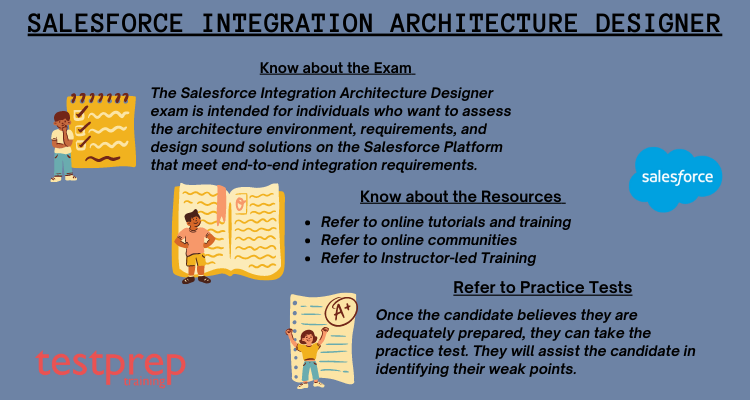The Salesforce Integration Architecture Designer certification exam is designed for architects, analysts, and application managers who want to create secure, scalable Lightning Platform integrations. The Salesforce Integration Architecture Designer exam is designed to evaluate a candidate’s ability to communicate technical solutions to technical stakeholders as well as present a project delivery framework that ensures quality and success.
Let us look at the Salesforce Integration Architecture Designer Preparation Guide!
About Salesforce Integration Architecture Designer
The Salesforce Integration Architecture Designer exam is intended for individuals who want to assess the architecture environment, requirements, and design sound and scalable technical solutions on the Salesforce Platform that meet end-to-end integration requirements. It is intended for architects, analysts, and application managers who want to create secure and scalable Lightning Platform integrations. Furthermore, it assesses a candidate’s ability to effectively communicate technical solutions with technical stakeholders as well as present a project delivery framework that ensures quality and success.
Audience Discription
A Salesforce Integration Architecture Designer evaluates the integration requirements required to design secure, scalable Salesforce Platform integration solutions. The designer has prior experience designing and implementing complex integration patterns across multiple platforms, as well as communicating the solution and design trade-offs to both business and technical stakeholders.
The Salesforce Certified Integration Architecture Designer’s background is as follows:
- Salesforce Integration Architecture experience of 1 to 2 years
- 2–3 years of hands-on Salesforce administration and/or developer experience.
- 1 year of experience supporting or implementing data-centric enterprise integration solutions.
Typical job roles may include:
- Architect of Technology
- System Architects who specialize in the integration
- Analyst Programmer
- Manager of Applications
- Architect of Integration
- Architect of Solutions
Skills and Knowledge Required
The following are the Salesforce Certified Integration Architecture Designer prerequisites:
- Create integrations with the Lightning Platform and other enterprise applications that are fast, secure, and dependable.
- Examine current and future state integration architectures.
- Create and maintain the project’s Integration Architecture blueprint.
- Integrate with other enterprise and cloud-based applications.
- Effectively communicate architecture design to a wide range of stakeholders at various levels.
- In terms of integration, adhere to best Domain practises.
- Create interface security mechanisms that are both robust and scalable.
Let us now move on to the main point of the article –
How to become a Salesforce Integration Architecture Designer?
The Salesforce Integration Architecture Designer exam is intended for individuals who want to assess the architecture environment, requirements, and design sound and scalable technical solutions on the Salesforce Platform that meet end-to-end integration requirements. Let us begin with the exam preparation –

Step 1 – Know in-depth about the exam syllabus
Below mentioned is the detailed course outline for the exam along with the documentation and whitepapers offered by Salesforce –
Evaluate the Current System Landscape: 8%
- Given a set of business requirements, identify the current system landscape and determine what standards, limitations, boundaries and protocols exist. ( Salesforce Documentation: Pattern Approach)
- also, Given an existing system landscape, analyze for constraints and/or pain-points to satisfy a business requirement(s). ( Salesforce Documentation: Integration Patterns and Practices )
- furthermore, Given a set of requirements, evaluate the authentication and authorization needs based on the system landscape.
Evaluate Business Needs: 11%
- Given a use case, identify functional and non-functional requirements needed for integration.
- also, Based on a given integration requirement, identify and classify data into Confidential/Secure/Public.
- furthermore, Given a use case, identify key factors for CRM success that should be included as integration requirements. ( Salesforce Documentation: Salesforce CRM Content )
- moreover, Given a use case, identify the business growth and regulatory factors that can impact choice of integration solutions. ( Salesforce Documentation: Integration Patterns and Practices )
Translate Needs to Integration Requirements: 22%
- Given an existing system landscape diagram, create an inventory of the systems and integration patterns.
- also, Given a use case and business process, evaluate system and process constraints. ( Salesforce Documentation: Pattern Summary )
- furthermore, Given a use case, identify integration security / authentication / authorization requirements.
- moreover, Given a use case, identify performance needs (volumes, response times, latency) and propose appropriate integration solutions that will meet business requirements. ( Salesforce Documentation: Purpose and Scope )
Design Integration Solutions: 28%
- Given a use case, identify the integration pattern that meets business requirements. ( Salesforce Documentation: Integration Patterns Overview )
- also, Given a use case, define the components which create a solution that meets business requirements. ( Salesforce Documentation: Pattern Selection Guide )
- furthermore, Given a use case, identify the trade-offs, limitations, and constraints that meet the proposed solution. ( Salesforce Documentation: Pattern Approach )
- moreover, Given a use case that includes technical requirements, constraints or drivers, specify the appropriate Salesforce API(s) for the proposed solution. ( Salesforce Documentation: Understand the Salesforce Architecture )
- also, Given a use case that includes technical requirements, constraints or drivers determine the standards, components, techniques, and security mechanism that should be used.
Build Solution: 23%
- Given a use case that includes technical requirements, constraints or drivers, identify the considerations when designing and implementing API(s), both Salesforce as an API provider and Salesforce as an API consumer. ( Salesforce Documentation: Understand the Salesforce Architecture )
- Given a use case, identify the considerations when choosing the right option in making an outbound call to an external system.
- furthermore, Given a use case, describe what should be considered when building a scalable solution.
- moreover, Given a use case, determine error handling for different integration options. ( Salesforce Documentation: Test in the Integration Environment and Deploy Changes )
- Given a use case, create a security solution for inbound or outbound integrations. ( Salesforce Documentation: Salesforce Integration v2 )
- Given a use case, identify the factors needed to build resilience in an integration solution for system updates. ( Salesforce Documentation: Systems Integration and Data Security )
Maintain Integration: 8%
- Given an integration maintenance use case, identify performance monitoring needs for integration requirements. ( Salesforce Documentation: Integration Patterns Overview )
- also, Given a use case, identify the appropriate error handling, escalation and recovery procedures for a failed integration.
- furthermore, Given a use case, identify reporting needs for integration monitoring. ( Salesforce Documentation: Real-Time Event Monitoring )
Step 2 – Know about the Exam Format
Another thing that the candidate should be aware of is the exam’s fundamentals. The critical step is to describe the format and necessary details of the Salesforce Integration Architecture Designer. These are some important details that an individual should be aware of before taking the exam –
- The exam consists of 60 questions. In addition, the Salesforce Certified Integration Architecture Designer Exam Questions will be in multiple-choice or multiple-select format.
- Furthermore, the candidate will have 105 minutes to complete the exam. This exam has a pass rate of 67 percent.
- Furthermore, the candidate must pay a registration fee of $400 USD plus applicable taxes. The retake exam fee is USD 200, plus any applicable taxes mandated by local law.
Step 3 – Gather all other important details about the exam
These are some policies of which you should be aware of when you will be taking this exam –
Policy on pricing
The Salesforce Integration Architecture Designer Exam registration fee is USD 400 plus applicable taxes. The charge, however, may vary depending on the region, and taxes are also subject to change.
Policy on scoring
The passing score for the Salesforce Integration Architecture Designer Exam is 67 percent, which is quite achievable. Because the questions are in MCQ format, your responses must be very clear and direct. This is doable if you have good study materials.
Policy of retake
The cost of retaking the Salesforce Integration Architecture Designer exam is half that of the first time. As a result, the retake cost $200. Salesforce upgrades all certification examinations three times a year, in tandem with Salesforce release cycles (Winter, Spring, Summer). During each release cycle, you have three chances to take the same certification exam (i.e., Salesforce Certified Administrator). All attempts will be reset when the next release cycle begins. As a result, the same exam can be taken three times in a single release cycle.
Step 4 – Refer to the best Resources
Different resources have different sets of knowledge and comprehension. However, in academic life, revision should be done on a case-by-case basis. As a result, matching the type of revision you do on your source material is critical.
Salesforce Study Guide
The Salesforce Integration Architecture Designer Study Guide is the next step. The study guide for the Salesforce Integration Architecture Designer exam is available on the Salesforce website. As previously stated, the Exam Outline is the most important component of any certification exam. This guide contains information about the certification exam’s target audience, recommended training and documentation, and a complete list of exam objectives—all to assist you in achieving a passing score. To increase your chances of passing the exam, Salesforce recommends a combination of on-the-job experience, course attendance, and self-study.
Salesforce Integration Architecture Designer Trailhead
When it comes to Salesforce, the most important aspect of your preparation guide is Trailhead. Trailheads are, indeed, very useful resources for preparing for such an exam. You can use Trailhead to review online documentation, tip sheets, and user guides, as well as search for and study the topics listed in the Exam Outline section of this guide.
Salesforce Integration Architecture Designer Training
Getting some hands-on experience is essential for exams such as Salesforce Marketing Cloud Administrator. The Training Course is your key to passing the exam. You can easily familiarise yourself with training courses for the same. Salesforce provides the candidate with several options from which to choose. Training courses are highly recommended by Testprep Training. The understanding here is that a problem should be viewed from every angle possible, not just one.
Join a Study Group
The candidate must acquire and share knowledge to pass the Salesforce Marketing Cloud Administrator exam. As a result, we recommend that you participate in a study where you can discuss the concepts with others who share your goal. This will guide the candidate throughout the preparation process.
Practice Test
The most important step is to take the practice test. Salesforce Integration Architecture Designer Practice Exams provide candidates with confidence in their preparation. Nowadays, there are numerous practice tests available on the internet; the candidate can select whichever one they prefer. The Salesforce Marketing Cloud Administrator practice test is extremely helpful in preparing for the exam. So, begin preparing right away!
Step 5 – Take the exam in accordance with the Expert’s Advice
The advantage of having this certificate is that you will always be aware of new product releases and updates. This certification is suitable for job roles such as technical architect, application manager, solution architect, and so on. It will provide a solid and necessary boost to your career.
To pass the exam, you must prepare thoroughly and take Salesforce Integration Architecture Designer Practice Exams. It determines your exam success rate. Furthermore, it has been proven that taking practice tests is one of the most effective ways to prepare for any professional exam.





